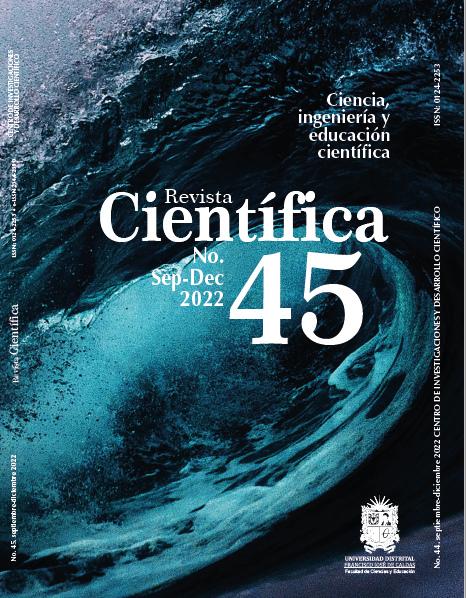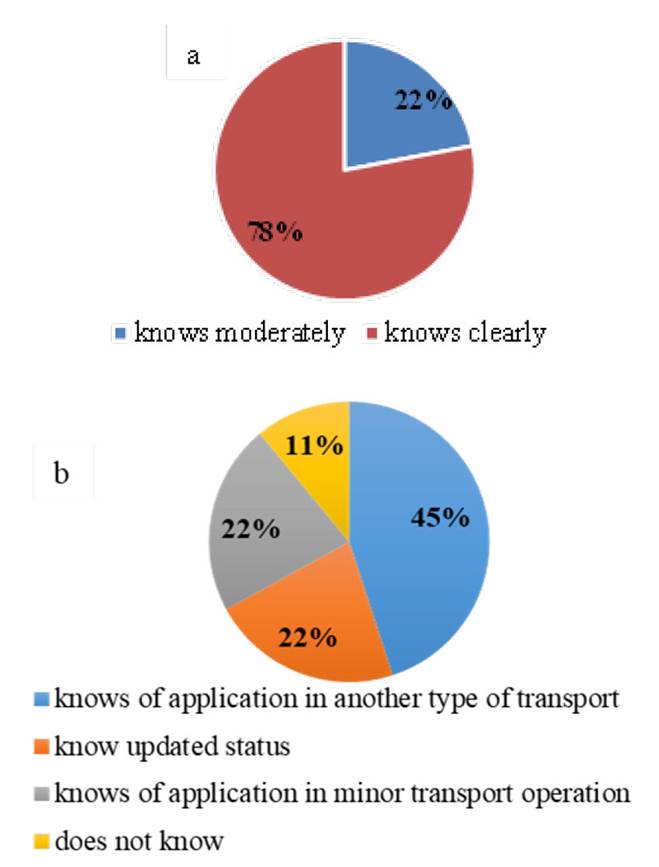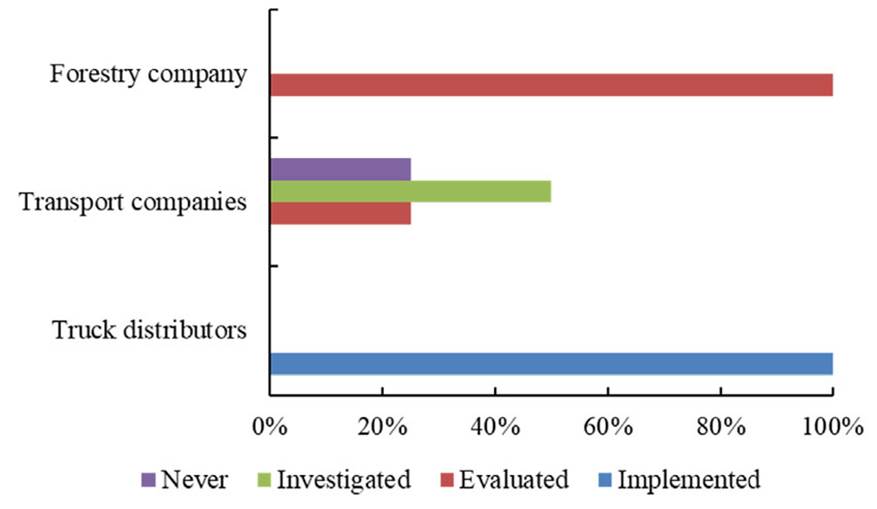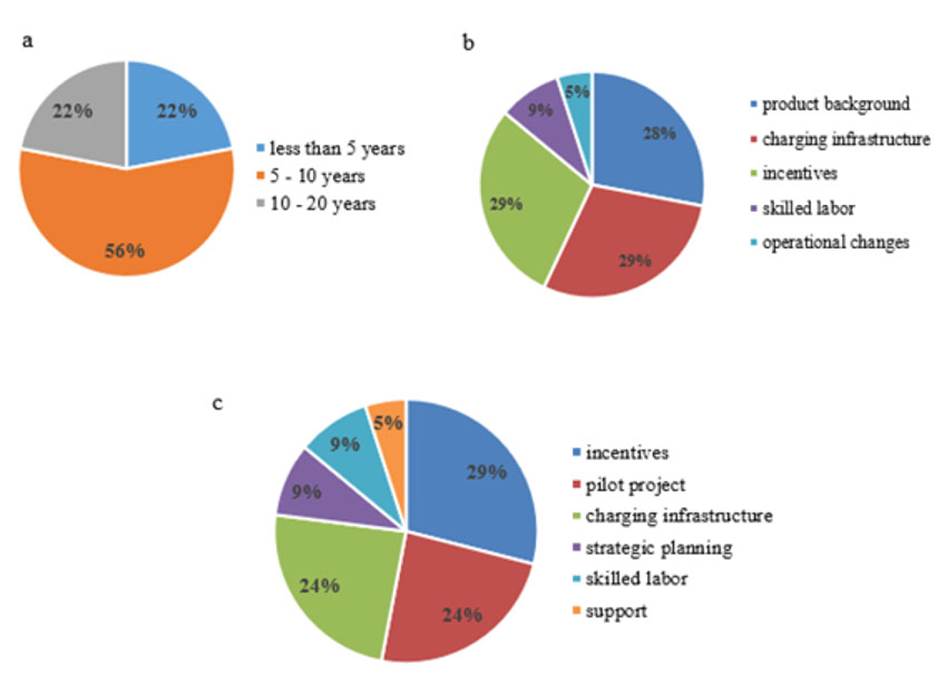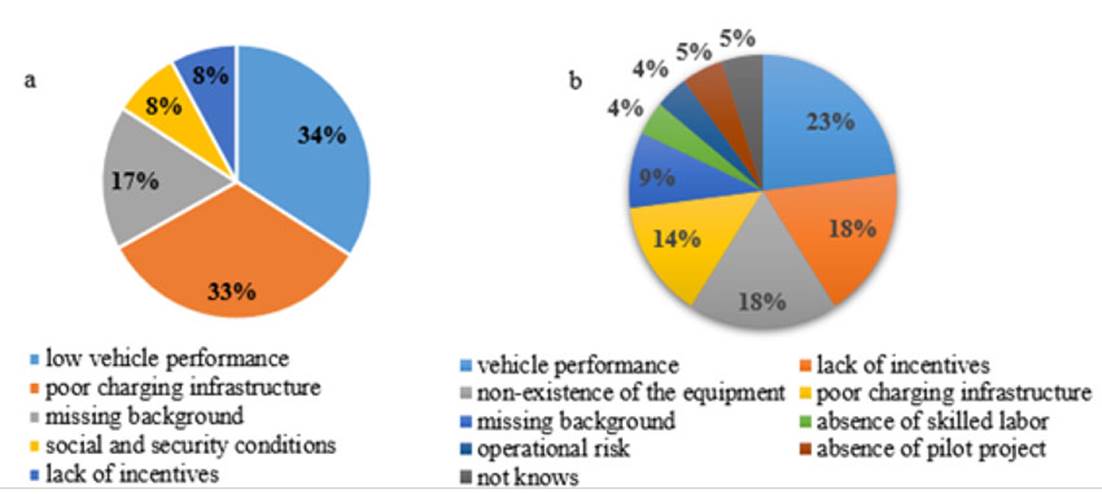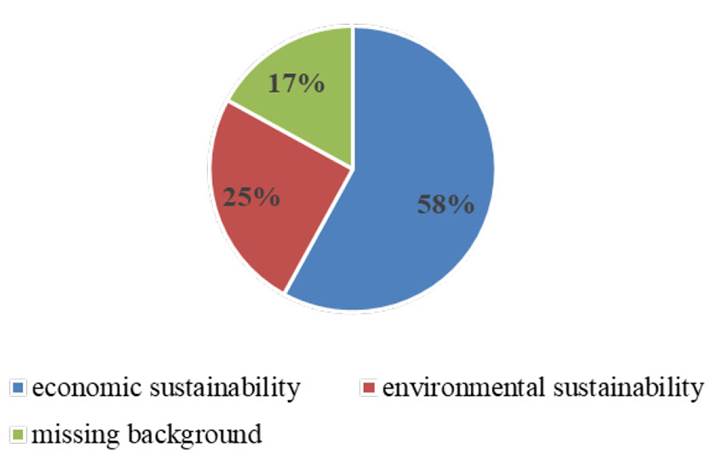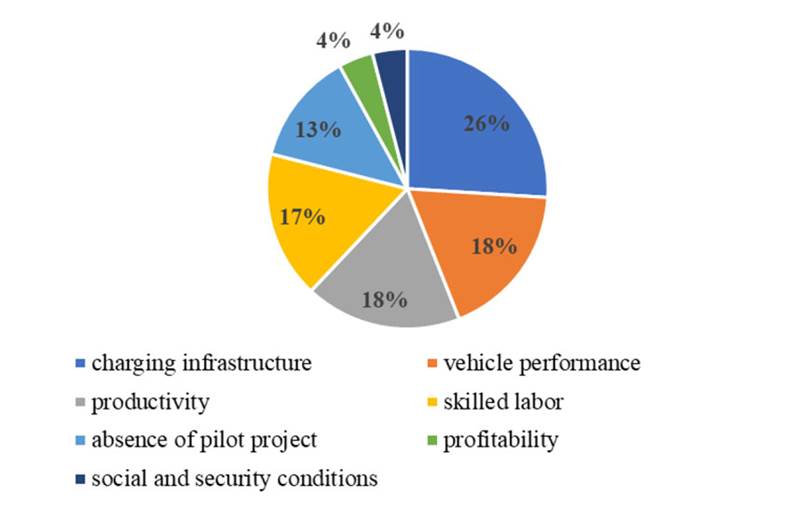DOI:
https://doi.org/10.14483/23448350.18863Published:
09/07/2022Issue:
Vol. 45 No. 3 (2022): September-December 2022Section:
Ciencia y TecnologíaElectromobility in Forest Transport. Is It Feasible? Perceptions Regarding Implementation in the Chilean Industry
Electromovilidad en transporte forestal. ¿Es factible? Percepción de implementación en la industria chilena
Keywords:
Electromovilidad, Transporte forestal, Camiones eléctricos, Sustentabilidad, Logística (en).Keywords:
electric trucks, electromobility, forest transport, logistics, sustainability (es).Downloads
References
Andalaft Ch., A., Landeros B., R., Perret G., J. (2005). Caracterización de la industria de servicios de transporte forestal en Chile y estrategias competitivas de las firmas. Bosque, 26(3), 137-148. https://doi.org/10.4067/S0717-92002005000300016 DOI: https://doi.org/10.4067/S0717-92002005000300016
Banco Central de Chile. (2019). Cuentas Nacionales de Chile 2018. https://www.bcentral.cl/documents/33528/762418/CuentasNacionales_segundo_trimestre2018.pdf/b0d6f7e4-c9b9-8b39-75c5-3f4c61255619?t=1573278093493
Banco Central de Chile. (2020). Cuentas Nacionales de Chile 2013-2019. https://si3.bcentral.cl/estadisticas/Principal1/Informes/AnuarioCCNN/pdf/ANUARIO_CCNN_2019.pdf
Freight Electric Vehicles in Urban Europe (FREVUE). (2020). FREVUE results and guidance for vehicle suppliers. https://frevue.eu/wp-content/uploads/2017/09/FREVUE-Results-and-Guidelines-for-Vehicle-Suppliers-v_09.pdf
García-Ruíz, M. (2015). Pasado, presente y futuro de vehículos eléctricos [Undergraduate Thesis, Universidad Tecnológica de Pereira, Colombia]. https://repositorio.utp.edu.co/items/f436b95e-ae5c-42e2-a637-aa99042fc36e
Instituto Forestal (2020). Chilean statistical yearbook of forestry 2020. https://wef.infor.cl/index.php/publicaciones/boletines-estadisticos/anuario-orestal.
Iwan, S., Allesch, J., Celebi, D., Kijewska, K., Hoé, M., Klauenberg, J., Zajicek, J. (2019). Electric mobility in European urban freight and logistics-status and attempts of improvement. Transportation Research Procedia, 39, 112-123. https://doi.org/10.1016/j.trpro.2019.06.013. DOI: https://doi.org/10.1016/j.trpro.2019.06.013
Jones, A., Begley, J., Berkeley, N., Jarvis, D., Bos, E. (2020). Electric vehicles and rural business: Findings from the Warwickshire rural electric vehicle trial. Journal of Rural Studies, 80, 395-408. https://doi.org/10.1016/j.jrurstud.2020.08.007. DOI: https://doi.org/10.1016/j.jrurstud.2020.08.007
Liimatainen, H., van Vliet, O., Aplyn, D. (2019). The potential of electric trucks - An international commodity-level analysis, Applied Energy, 236(15), 804-814. https://doi.org/10.1016/j.apenergy.2018.12.017. DOI: https://doi.org/10.1016/j.apenergy.2018.12.017
Madera-Ramos, J. M. (2019). Escenarios para el cambio de vehículos con motor de combustión interna a vehículos eléctricos en el transporte de carga en Colombia [Master’s thesis, Universidad Nacional de Colombia]. https://repositorio.unal.edu.co/handle/unal/77132
Maza-Ortega, J.M., Núñez-Hernández, F., Arcos-Vargas, A. (2018). Propuestas para el fomento de la movilidad eléctrica: Barreras identificadas y medidas que se deberían adoptar. Real Academia de Ingeniería de España
Ministerio de Energía. (2020). Estrategia nacional de electromovilidad. https://www.energia.gob.cl/sites/default/files/estrategia_electromovilidad-8dic-web.pdf
Ministerio de Energía. (2021). Plataforma de electromovilidad. https://energia.gob.cl/electromovilidad
Ministerio de Transportes y Telecomunicaciones. (2010). Decreto 120: Modifica Decreto No. 94 (establece condiciones para el transporte de productos forestales que indica). https://www.bcn.cl/leychile/navegar?idNorma=1009969&idParte=8818803
Quintana-Peña, A. (2006). Metodología de investigación científica cualitativa. In A. Quintana-Peña, & W. Montgomery (Eds.), Psicología tópicos de actualidad (1st ed., pp. 65-73). UNMSM
Rodríguez-Gómez, G., Gil-Flores, J., García-Jiménez, E. (1996). Metodología de la investigación cualitativa. Ediciones Aljibe
Ros-Marín, J.A., Barrera-Doblado, O. (2017). Vehículos eléctricos e híbridos. Paraninfo
Wang, W., Saari, R. K., Bachmann, C., Mukherjee, U. (2020). Estimating transboundary economic damages from climate change and air pollution for subnational incentives for green on-road freight. Transportation Research Part D: Transport and Environment, 82, 102325. https://doi.org/10.1016/j.trd.2020.102325 DOI: https://doi.org/10.1016/j.trd.2020.102325
How to Cite
APA
ACM
ACS
ABNT
Chicago
Harvard
IEEE
MLA
Turabian
Vancouver
Download Citation
Recibido: de enero de 2022; Aceptado: de junio de 2022
Abstract
This paper examines the different impressions and perspectives related to the implementation of electromobility in log transportation via trucks with a load capacity of up to 45 tons in the forestry sector of the eighth and sixteenth regions of Chile. The objective of this work is to establish the critical variables identified and perceived by key stakeholders of the forestry industry the correct implementation of high tonnage electric trucks. To this effect, a qualitative methodological study with a non-experimental design is proposed, which is based on semi-structured interviews conducted with stakeholders of the forestry sector of the study area. A convenience sample is employed, which was applied to four businessmen in the sector, three executives from the main forestry companies, and two truck distributor representatives. The data show that there is currently little knowledge due to the lack of specific projects and platforms for disseminating information that consider this technology in the field, but, on the contrary, they show a willingness to implement pilot plans aiming for the perceived economic sustainability of electromobility. A concentration of critical aspects is evidenced, which must be addressed in order to implement electromobility in forest transport, and which, given handling by public-private work, would enable the sector and the country to obtain the economic and environmental benefits of this technology.
Keywords:
electric trucks, electromobility, forest transport, logistics, sustainability..Resumen
Este trabajo examina las distintas impresiones y perspectivas relacionadas con la implementación de electromovilidad en el transporte de rollizos con camiones de capacidad de carga de hasta 45 toneladas en el sector forestal de la octava y decimosexta región de Chile. El objetivo de este trabajo es establecer los aspectos críticos que los actores claves de la industria forestal identifican y perciben para una correcta implementación de camiones eléctricos de alto tonelaje. Para esto se propone un estudio metodológico de tipo cualitativo con un diseño no experimental basado en entrevistas semiestructuradas dirigidas a actores del sector forestal de la zona estudio. Se utiliza una muestra por conveniencia aplicada a 4 empresarios del rubro, 3 ejecutivos de empresas forestales principales y 2 representantes de distribuidores de camiones. Los datos muestran que actualmente hay poco conocimiento, derivado de la inexistencia de proyectos y plataformas de difusión específicos que consideren la tecnología en el rubro, pero, por el contrario, demuestran que existe una buena disposición por parte de los actores para implementar planes piloto con miras a la sustentabilidad económica que se le proyecta a la electromovilidad. Se evidencia una concentración de aspectos críticos que es necesario abordar para implementar la electromovilidad en el transporte forestal y que, atendidos por un trabajo público-privado, permitirían al rubro y al país obtener los beneficios económicos y ambientales de esta tecnología.
Palabras clave:
camiones eléctricos, electromovilidad, logística, sustentabilidad, transporte forestal..Resumo
Este trabalho examina as diferentes impressões e perspectivas relacionadas à implementação da eletromobilidade no transporte de toras com caminhões com capacidade de carga de até 45 toneladas no setor florestal da oitava e décima sexta regiões do Chile. O objetivo deste trabalho é estabelecer os aspectos críticos que os principais informates do setor florestal identificam e percebem para uma correta implantação de caminhões elétricos de alta tonelagem. Para isso, propõe-se um estudo metodológico qualitativo com desenho não experimental baseado em entrevistas semiestruturadas dirigidas a atores do setor florestal da área de estudo. Uma amostra de conveniência é aplicada a 4 empresários do ramo, 3 executivos de grandes empresas florestais e 2 representantes de distribuidores de caminhões. Os dados mostram que atualmente há pouco conhecimento, derivado da inexistência de projetos e plataformas específicas de divulgação que considerem a tecnologia no campo, mas, ao contrário, mostram que há disposição por parte dos atores em implementar planos piloto com você veja a sustentabilidade econômica que se projeta para a eletromobilidade. Há evidências de uma concentração de aspectos críticos que precisam ser abordados para implementar a eletromobilidade no transporte florestal e que, atendidos por obras público-privadas, permitiriam ao setor e ao país obter os benefícios econômicos e ambientais dessa tecnologia.
Palavras-chaves:
caminhões elétricos, eletromobilidade, logística, sustentabilidade, transporte florestal..Introduction
In recent history, commitments have been made in the global search for concrete actions to stop or mitigate climate change, which has become evident in the recent and latest edition of the Conference of Parties (COP) No. 25 of 2019, organized by Spain in Madrid and chaired by Chile, where a final document called Chile-Madrid: Time for Action was drafted and approved. This document requests new commitments and challenges by nations to limit the global temperature increase to 1.5 °C and states a world consensus regarding the fact that science and technology are essential to this effect, as well as the awareness of the need to change the energy paradigm, which nowadays relies mainly on fossil fuels. In this sense, studies have been conducted around the world to explore electric trucks as a viable alternative, as they have generally shown good performance for transporting minor loads. However, they pose major challenges for heavy load transport, and considerations regarding their implementation depend on the conditions inherent to each country (Liimatainen et al., 2019).
According to the study carried out by Wang et al. (2020), the adoption of a 5% zero-emission load in Ontario, Canada, would imply a reduction of around 0.8 MtCO2e. This would by far exceed the targets established for reducing greenhouse gasses in this region. Chile’s position in the electric automobile market is small and shows an incipient stage of introducing technology for electric vehicles. In general, there are public and private initiatives trying to encourage the use of this technology and define long-term public goals in order to establish concrete targets for private vehicles and public transport by 2050, with 40 and 100% of electromobility participation, respectively. To this end, Chile has structured a national electromobility strategy containing the following specific goals: a) establishing regulations and standardization, b) boosting electromobility in public transport in the entire country, c) supporting research and development, d) boosting development in the market, and e) generating spaces for knowledge transfer and information supply (Ministerio de Energía, 2020).
Electromobility: Theory and Definitions
Electric Load Vehicles (ELVs), regardless of their load capacity, are those that obtain their engine capacity from electrical power, unlike conventional vehicles, which obtain it from the combustion of fossil fuels such as oil. Even though these vehicles have been part of mass consumption only since 2008, it is important to mention that they were invented in the 19th century, in full global competition and growth, and that, in 1912, one third of vehicles in the United States were electric (Ros-Marín and Barrera-Doblado, 2017). Nonetheless, since the beginning of the 20th century, ELVs started to become less important than Internal Combustion Vehicles (ICVs) because of their limited autonomy, their recharge times, the easy access to oil, and the advent of the Ford Model T to the market (García-Ruíz, 2015).
In the literature, two types of ELV can be identified: those that obtain energy released from batteries that can convert stored chemical energy into electricity, and those that obtain it directly from an electricity grid to which they are permanently connected, with the former having the alternative of direct battery charging or a battery change system (García-Ruíz, 2015).
The literature also shows a series of matching advantages and benefits of ELVs: from strategic (ceasing to depend on fossil fuels), to environmental (reducing greenhouse gas emissions). According to Jones et al. (2020), if factors such as the travel autonomy, recharge speed and infrastructure, and sales cost of these vehicles are successfully addressed, this technology can be made viable for commercial and industrial use. All of the aforementioned poses challenges to science and politics to generate incentives, define regulations, and contribute to infrastructure in order to boost this technological trend (Ministerio de Energía, 2020).
Public Policies to Encourage Electromobility
Studies on electromobility in Europe show that a limited ELV offer generates high purchase prices. Moreover, because many logistics operators do not know and/or have little experience in the field, a small dynamic market has emerged in countries such as Germany, Denmark, Poland, and Turkey. Therefore, many decisions related to investing in ELVs have been discarded, as economic assessments regard them as non-profitable, especially for medium- to high-ton vehicles (> 5t) (Iwan et al., 2019).
In order to boost the electromobility market for load vehicles, it is essential to combine efficient policies with knowledge exchange platforms. To solve this, the European Commission and Electric Mobility Europe (EMEurope) funded the EUFAL project (Electric and Urban Freight and Logistics) to build an exchange platform, so that companies could manage ELV implementations in mixed fleets and multi-level distribution concepts. A survey conducted within the framework of the FREVUE project (Freight Electric Vehicles in Urban Europe) in 2017 showed that, at the beginning of the project, only 39% of fleet managers perceived ELVs as a viable alternative next to diesel vehicles. The perception of those surveyed indicated that 72% believe that electric vehicles will be a viable alternative. Given this, for these platforms to operate effectively within a regulatory framework, infrastructure and supporting incentives are required (FREVUE, 2020).
Incentives for the development of electromobility may include a variety of incentives in European countries and are mainly based on facilitating access for the acquisition of electric vehicles, as well as, to a lesser extent, the development of electric recharge infrastructure. These factors are regarded as key in the implementation of this technology (Maza-Ortega et al., 2018).
Current Situation Regarding Electromobility in Chile and Projects for High Load Transport Around the World
The literature features several analyses regarding the potential of ELVs. They are quite recent, but no less promising. For example, in Finland, tests were conducted with high-load articulated trucks across distances over 100 km (Liimatainen et al., 2019). This led to the conclusion that there is a low potential to transport load only with batteries if their capacities are not improved. However, this alternative becomes attractive in combination with electrified roads to recharge the batteries without the need to stop the truck, as well as with quick-charge centers in resting stations or logistics centers. It is worth mentioning that ELVs will have a significant effect on the energy grid because they imply an increase in the load demand, so the routes need to be analyzed in order to locate the most important charging stations (Liimatainen et al., 2019).
Since May 2019, Chile has had a digital platform on electromobility led by the Ministry of Transport and Telecommunications and the Ministry of Energy (2021), which is part of the public-private commitment to boost electromobility in the country. This platform contains information on the sector, such as the cost of electric vehicles, the regulatory framework, modifications or new regulations, training offered on the topic, ongoing projects, and the characteristics of ELVs both in Chile and around the world. Said platform contains a summary of the experience with electromobility in the country, including such as a company that has included four trucks with a load capacity of 1.6 tons and a truck with a load capacity of 13.0 tons into its urban transport fleet.
Forest Transport of Logs with Trucks
In Chile, forest transport has traditionally been performed by trucks, as they meet the strength and versatility requirements to access the demanding topography of woods and the flexibility necessary to address the widespread network of loading and unloading centers. They have also allowed meeting the cost requirements of the industry (Andalaft et al., 2005).
Nowadays, trucks are mostly ICVs with horsepower between 300 and 500, which makes them easy to operate on forest roads. Logging trucks have structures formed by square high-resistance steel profiles fitted perpendicularly onto the truck’s chassis and a beam on each end, which are jointly called the log rack, with characteristics and standards duly established by law (Ministerio de Transporte y Telecomunicaciones, 2010). These trucks have four to six racks on their chassis, which can be fixed or mobile and are equipped with trailers of an average fixed 7.2 m length in order to transport long logs between 2.0 and 8.0 m, or loggers with a telescopic tow bar for long logs of up to approximately 17 m. Thus, the loaded equipment must observe the maximum weight capacity in the country, which is regulated according to axis and total weight, i.e., a maximum of 45 tons in the case of Chile (Law N°19,171, 1992). Thereupon, in 2017, transport in logging trucks in Chile moved 98.8% of the load, relegating other means of transport such as trains to a faraway second place, despite their potential for the sector. This predominant trend of highway transport by trucks is constant in all countries in America and the world, regardless of their development or territory conditions (Quintana-Peña, 2006).
As for the types of fuel used by trucks in Chile and the rest of the world, diesel-based internal combustion motors have the upper hand. The 2018 transport statistics report of the United Nations Economic Commission for Europe shows that, for countries in Europe, Central Asia, and North America, trucks with a loading capacity of over 3500 kg predominantly use diesel-type fuel, and that electric vehicles only represent 0.0419% of the existing units (Quintana-Peña, 2006). Only seven out of the 19 surveyed countries have electric vehicles with a loading capacity over 3500 kg. The countries concentrating the highest number of electric vehicles are Poland, United Kingdom, France, and Spain, but none of these countries exceed 0.01%, nor have they shown a clear upward trend in the past three years.
Understanding this reality, and considering the bibliographical analysis presented, the following question can be asked: What are the critical variables that make the implementation of electromobility in forest transport possible?
In this sense, a large portion of the Chilean forest industry has policies and guidelines in matters of sustainability, but there are sectors such as transport that, despite the implementation of important technological innovations in the equipment, have had no relevant impact in terms of minimizing or eliminating the use of fossil fuels. In view of the above, it is vital to understand, from a technical viewpoint, the motivations and concerns that stakeholders in the forest transport sector consider relevant to assess the implementation of electric trucks as an alternative to conventional load vehicles.
After going over the fundamental theoretical bases for this study, it is worth noting that its main motivation is to improve the understanding of the critical variables that facilitate the implementation of electromobility in Chilean forest transport, thus enabling this industry to take the first steps towards becoming a carbon-neutral activity while keeping the current standards achieved regarding productivity, costs, and operation. With this in mind, this work aims at establishing the critical variables identified and perceived by stakeholders of the forest industry as necessary for a correct implementation of electromobility-based high-load trucks.
Methodology
Paradigm and Design
The design of this research involves a non-experimental study based on a qualitative methodology with semi-structured interviews. This is the most commonly used alternative, which, with questions prepared beforehand, guarantees the interview’s structure and goals, thus enabling to go a bit further in order to explore aspects of the interviewee’s answer. It can be complemented with a non-verbal language analysis (Quintana-Peña, 2006) and sequentially applied following a business-type classification represented by the interviewees from a convenience sample. Further, based on the interviewees’ experience, ensures a high-quality description of the topic’s specifics (Rodríguez Gómez et al., 1996).
Thus, forest truck suppliers of the country were first interviewed to gather information on the availability of electric trucks in the Chilean market, focusing on compliance with the minimum technical specifications to perform forest operations, i.e., the autonomy of electric trucks, their strength, their load capacity, and the availability of maintenance services. Then, businesspeople and forest transport service company managers from the studied regions were interviewed in order to understand their perceptions, concerns, and attitude regarding the feasibility -or not- of implementing forest transport with electric trucks. Finally, executives from the main forest company in the region were interviewed in order to explore their perception, plans, and intentions regarding the subject. The investigation was exploratory, systematic, and empirical. The results were observed and analyzed in their normal and general development in order to facilitate thinking with analysis towards discovery (Quintana-Peña, 2006). The data was analyzed based on a research methodology with transversal temporality, so the interviews were held once.
Study Population
For this study, three executives from the main companies, four transport company managers, and two truck suppliers were interviewed. All interviewees, regardless of their type, have a high level of expertise in the field and hold high hierarchical positions in each of their companies, such as heads of unit, general managers of forest transport companies, and area managers of truck distributors. 78% of the interviewees have complete university studies and an average experience in the field of 17 years. Three hold postgraduate degrees. The age of the interviewees ranges between 33 and 66 years old, with 89% being older than 41.
Environment
The study covered the eighth and sixteenth regions of Chile as representative regions of forestry industry, whose relevant economic sectors include financial services, real estate, construction, electricity, gas, water, personal services, and forestry, reaching a GDP of 13 497 billion pesos (14.48 billion USD) in 2017 (Banco Central de Chile, 2019, 2020) and contributing with 7.5% of the GDP.
These regions are regarded as the engine of the Chilean forestry sector and are the place of operations for the country’s three most relevant major-scale forestry stakeholders, which jointly manage a territory of 1 286 000 ha of forest plantations for industrial use. In total, the forestry sector contributes 1.7% to Chile's GDP, totaling 3 176.6 trillion Chilean pesos (USD 3.41 trillion) (Banco Central de Chile, 2019, 2020). The Chilean forestry sector generates 113.8 thousand jobs, which are subdivided into the primary, secondary, and forestry and extraction forestry industries. The main products generated by this sector include chemical pulp, sawn wood, boards and veneers, chips, and others, whose exports reached USD 6 838 million and a consumption of 47 854 215 m3ssc of saw and pulpable wood in 2018 (Instituto Forestal, 2020). The forest transport model is composed of forestry companies that act as client companies or customers and generally tender or negotiate forest transport services with specialized companies in order to take advantage of the economies of scale and experience they have with regard to logistics. It is estimated that there are around 80 companies specializing in industrial-scale forest transport with fleets ranging from 5 to 100 trucks. These trucks complete around 60 000 monthly trips covering average distances per loaded trip of around 120 km.
Interventions
Interviews were conducted with the main suppliers of trucks and forestry companies to carry out a survey of the key aspects indicated in the design of the study. To this effect, voice recorders and a written document with the questions guide of the discussion were used. The interviews considered 11 base questions divided into three stages: 1) characterizing the present and understanding reality, 2) high-impact proposals, and 3) alerts on transformation.
Instrument Verification and Validation Methods
The instrument was analyzed and validated by expert professors from Universidad del Desarrollo’s School of Engineering. Suggestions and modifications were taken into account for the interview to match the research design.
Data Analysis Plan
The data analysis considered the grouping and tabulation of the interview results, with the purpose of understanding the current scenario around the knowledge of this technology and its feasibility in the main forestry companies of Chile. Perceptions and paradigms regarding short and medium-term implementation were identified, with which the baseline variables that influence the decision to adopt this technology could be determined.
Ethics
During the research, special emphasis was made on demonstrating that researchers had no interest nor obtained benefits with regard to the interviews conducted. Voluntary participation was achieved through transparency, providing different study participants with sufficient information and handling the information provided with a high degree of confidentiality. Regarding the results, it can be assured that they were processed without pressures or influences in order to cancel out any bias in the data or opinions. In addition, the observations and assessments of the interviewees were conducted and analyzed in their normal and real context. Finally, it is confirmed that nowhere in the process was there any deliberate manipulation of the study variables.
Results and Discussion
Knows the evidence of this study regarding the characterization of the present and the understanding of reality indicates that almost 78% of the participants clearly understand the concept of electromobility (Figure 1a). This knowledge drops considerably when consulting the updated status of its application in load transport, where only 22% of the interviewees manifest updated knowledge of its use (no load transport entrepreneur gave any positive answers) (Figure 1b). The greatest knowledge of its use in other means of transport is mainly associated with the Santiago Metropolitan Mobility Network of Public Transport, which is directly related to Chile's first national electromobility strategy (Ministerio de Energía, 2020) and whose focus is to establish public passenger transport as an engine for the development of this technology.
Fig. 1: Interviewees’ response to the following questions: a) What do you understand by electromobility? b) Do you know the current state of its use in load transport?
The results reaffirm this, as only the interviewees of the truck distribution business state that they have implemented projects associated with electromobility, a situation that only involves evaluating of this type of technologies in client companies’ operations, highlighting only one project that has already been authorized and is in the stage of importing electric equipment. This relegates forest transport companies in the regions of Ñuble and Biobío to an earlier stage of exploration and approach to electromobility (Figure 2), which, as mentioned before, is in agreement with the requirements that originated of their main client, but this has not yet evolved into any specific project that incorporates or considers this type of technology, which was mentioned by Iwan et al. (2019), who argued that, in countries such as Germany, Denmark, Poland, and Turkey, a non-dynamic market has emerged because most logistics operators do not know and/or have little experience in the field.
Fig. 2: Interviewees’ response to the following question: In your company, has any evaluation or implementation of this technology been developed?
As for the time estimates given by the interviewees, who mostly estimated that this technology will be able to compete against high-load diesel trucks in 5 to 10 years (Figure 3a). It is important to note that these are framed within what was reported by Madera-Ramos (2019), estimating that, for Colombia, the economic equilibrium point between ELVs and ICVs will occur between the 2025 and 2028, depending on whether or not travel restrictions are considered for ICVs.
As for the responses in the stage of proposals for high-impact implementation, it is worth noting that, despite the low implementation and knowledge on current projects in the industry, there is a concern about the key aspects to promote this type of technology, which are of great consensus and transversal among the stakeholders of the industry, highlighting the need for a battery of incentives of public origin and the need to implement a charging infrastructure (Figure 3b), in order to provide the necessary coverage for the ranges of forestry operations (Maza-Ortega et al., 2018). Among the main incentives implemented in European countries to promote electromobility, support for the acquisition of electric vehicles and -to a lesser extent- the development of electric charging infrastructure can be identified. This is reaffirmed by Jones et al. (2020), who concluded that, in order to make rural electric transport more effective, the high cost of these vehicles, their autonomy, and the charging infrastructure available in the area of action need to be addressed (Figure 3c).
Fig. 3: Interviewees’ response to the following questions: a) In your experience, in what timeframe do you think this technology will be competitive with high-load diesel trucks and why? b) What factors do you think should exist in order to assess the implementation or incorporation of electric trucks in your company? c) Do you have specific proposals to drive the implementation of electric trucks in the short term and on a permanent basis?
Another factor that is reiterated by the interviewees is the greater availability of information on the equipment, i.e., regarding characteristics such as price, power, load capacities, maintenance needs, autonomy, etc. (Figure 4a). To estimate performance in forestry work, high-demand work must be considered due to topographical conditions, among other factors. This is complemented by the fact that all the interviewees indicated that a strategic model would be especially useful, including the key variables enabling them to implement electric vehicles in their organizations (Figure 4b). This is directly related to the results presented in FREVUE (2020), concluding that a platform for the dissemination and exchange of knowledge is necessary, which, combined with infrastructure, regulatory framework, and efficient incentives, enables companies to implement this type of vehicles.
Fig. 4: Interviewees’ response to the following questions: a) What kind of difficulty or risk could the implementation of this type of technology cause in the sector and in your organization? b) Why do you think electric trucks have not yet been introduced in Chilean forest transport and in your company?
This was also pointed out by Iwan et al. (2019), who stated that, in order to promote the use of this technology, public policies need to be combined with a platform for the exchange of both technical and economic knowledge, which would positively impact the perceptions of the main decision-makers.
Finally, when analyzing stage 3 (alerts on transformations), an approach aimed at obtaining economic benefits even over environmental ones is highlighted, which originates on the basis of the sustainability that this type of technology would provide. This is due to three main reasons: a) demands could arise from customers and that would allow companies to remain in operation by achieving a rapid and efficient transformation; b) the current market for carbon credits; and c) lower maintenance costs for electric trucks. This is directly related to that state by the Ministry in the National Electromobility Strategy (Figure 5).
Fig. 5: Interviewees’ response to the following question: What are the opportunities or benefits that you envision for the forestry sector and for your company in terms of the use of electric trucks?
As for the main concerns and difficulties expressed by the interviewees, there are common convergence factors additional to those already mentioned. A lack of information stands out, as can be seen in FREVUE (2020). An increase in technical knowledge regarding the type of technology generated a significant increase in fleet managers’ positive perception regarding the feasibility of implementing ELVs in load transport.
On the other hand, concerns related to the lack of trucks available in Chile for the forestry sector are addressed by Iwan et al. (2019), who state that there is a varied supply of electric load vehicles, which helps to reduce purchase prices, preventing many projects associated with electromobility from being discarded in the evaluation stages (Figure 6).
Fig. 6: Interviewees’ response to the following question: What would be your main concern at the time of the implementation of an electric forest-truck project?
Conclusions
After categorizing and prioritizing the opinions expressed by relevant stakeholders, it can be concluded that the main critical actions to enable the implementation of electromobility in forest transport are as follows: 1) promoting technology transfer in order to understand the performance of electric forest load trucks; 2) implementing a load infrastructure with spatial coverage and efficiency that do not affect the fleet’s productivity; 3) establishing public and/or private incentives to accelerate the formation of collaborative strategic partnerships between truck distributors and transport companies; and 4) preparing qualified maintenance personnel to ensure that the current standards achieved by the industry are maintained or improved. This is supported by analyzing and consolidating the key responses of stages 2 and 3, which helped to identify the main concerns, the greatest difficulties envisioned, and the factors technically considered as elementary for implementing electromobility in forest transport.
It is important to note that there is a concentration of the key aspects to make electromobility more effective in the forestry industry, which facilitates the design and implementation of effective action plans.
It should be noted that all the interviewees submitted specific proposals to help in the implementation of this type of technology in the industry, which, in general, are very much aligned with the critical factors identified. The current lack of this type of technology in Chile to meet the requirements of the current forestry industry can be covered by forest transport companies’ willingness to test it in order to accelerate or at least meet the development deadlines projected by stakeholders. This highlights the relevance of constituent forestry companies, who become key stakeholders in the incentives required by transport companies to implement electromobility in the forestry sector, given that the lack of incentives, a critical factor, cannot be covered by public policies alone.
That said, this work contributes to the identifying and understanding that key variables that make it possible to implement a strategy regarding the incorporation of electromobility into forest transport in the regions of Biobío and Ñuble. On the other hand, with the implementation of pilot plans, part of the critical gaps detected would be addressed in a rapid and effective way, which is seen as fundamental to understanding the potential of the technology, its real operating costs, the operational complications to be addressed, and, finally, the real benefits that this technology can provide to the forest industry and the country. In addition, the implementation of a single specialized exchange platform that allows bringing universities, suppliers, concessionaires, forest transport companies, forestry companies, and the government together is proposed in order to facilitate access to information, thus enabling assessments related to this technology with less uncertainty and increasing economic feasibility.
As a way to continue addressing the gaps mentioned in the document, future studies are proposed which focus on the following topics:
-
Analyzing strategies that make it possible to implement an energy recharging system with an economic, technical, and sustainable approach that contains the incentives and regulations for the development of a new business system and allows for the entry of new players to the market, in order to allow greater competition and benefits for consumers and electromobility.
-
Analyzing the batteries of public and/or private incentives implemented in countries leading the implementation of this technology, with the purpose of allowing for the introduction of electromobility on a productive scale in forest transport, covering the purchase of the vehicle, operating and energy costs, training and labor specialization, etc.
-
Performing economic comparative analyses between current diesel-truck technology and trucks based on electromobility.
Acknowledgements
Special thanks to the Engineering Faculties of Universidad del Desarrollo and Universidad Autónoma de Chile, who provided financial support for this paper, as well as to L. Reyes-Bozo from the Research and Doctoral Studies Vice-Principalship of Universidad Autónoma de Chile.
References
License
Copyright (c) 2022 Sebastián Larenas-Barra, Luis Méndez-Dedes, Héctor Valdés-González, Lorenzo Reyes-Bozo, Claudia Sandoval-Yáñez

This work is licensed under a Creative Commons Attribution-NonCommercial-ShareAlike 4.0 International License.
When submitting their article to the Scientific Journal, the author(s) certifies that their manuscript has not been, nor will it be, presented or published in any other scientific journal.
Within the editorial policies established for the Scientific Journal, costs are not established at any stage of the editorial process, the submission of articles, the editing, publication and subsequent downloading of the contents is free of charge, since the journal is a non-profit academic publication. profit.

